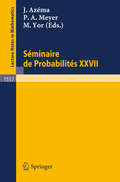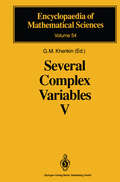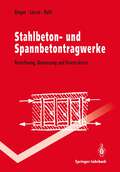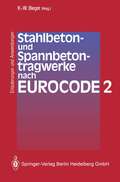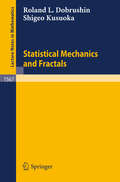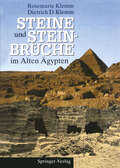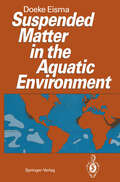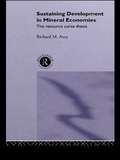- Table View
- List View
Seismic Effects of Blasting in Rock
by A.A. DauetasThe results of theoretical and experimental investigations of seismic waves depending on natural and technological factors are discussed, with methods for engineering calculations of industrial blast parameters.
Seminaire de Probabilites XXVII (Lecture Notes in Mathematics #1557)
by Jaques Azema Paul A. Meyer Marc YorThis volume represents a part of the main result obtained by a group of French probabilists, together with the contributions of a number of colleagues, mainly from the USA and Japan. All the papers present new results obtained during the academic year 1991-1992. The main themes of the papers are: quantum probability (P.A. Meyer and S. Attal), stochastic calculus (M. Nagasawa, J.B. Walsh, F. Knight, to name a few authors), fine properties of Brownian motion (Bertoin, Burdzy, Mountford), stochastic differential geometry (Arnaudon, Elworthy), quasi-sure analysis (Lescot, Song, Hirsch). Taken all together, the papers contained in this volume reflect the main directions of the most up-to-date research in probability theory. FROM THE CONTENTS: J.P. Ansal, C. Stricker: Unicite et existence de la loi minimale.- K. Kawazu, H. Tanaka: On the maximum of a diffusion process in a drifted Brownian environment.- P.A. Meyer: Representation de martingales d'operateurs, d'apres Parthasarathy-Sinha.- K. Burdzy: Excursion laws and exceptional points on Brownian paths.- X. Fernique: Convergence en loi de variables aleatoires et de fonctions aleatoires, proprietes de compacite des lois, II.- M. Nagasawa: Principle ofsuperposition and interference of diffusion processes.- F. Knight: Some remarks on mutual windings.- S. Song: Inegalites relatives aux processus d'Ornstein-Ulhenbeck a n-parametres et capacite gaussienne c (n,2).- S. Attal, P.A. Meyer: Interpretation probabiliste et extension des integrales stochastiques non commutatives.- J. Azema, Th. Jeulin, F. Knight,M. Yor: Le theoreme d'arret en une fin d'ensemble previsible.
Sequence Stratigraphy and Facies Associations (International Association Of Sedimentologists Series #100)
by Henry W. PosamentierIn recent years there has been a virtual explosion of stratigraphic studies utilizing the principles of sequence stratigraphy. Although the concept of time stratigraphy is not new, the packaging of depositional units into systems tracts and sequences is. This new approach has led to the reassessment of areas that in some cases have been the subject of intense geological scrutiny for decades. The fundamental principles upon which sequence stratigraphy is based are applicable at a broad range of temporal and physical scales. This volume arises from several sessions on sequence stratigraphy held at the Thirteenth International Sedimentological Congress, with emphasis on facies associations within a sequence stratigraphic framework.
Several Complex Variables V: Complex Analysis in Partial Differential Equations and Mathematical Physics (Encyclopaedia of Mathematical Sciences #54)
by C. A. Berenstein G. M. Khenkin A. Yu. Morozov R. G. Novikov A. M. Perelomov D. C. StruppaThis volume of the Encyclopaedia contains three contributions in the field of complex analysis; on mean periodicity and convolutionequations, Yang-Mills fields and the Radon-Penrose transform, and stringtheory. It is immensely useful to graduate students and researchers in complex analysis, differential geometry, quantum field theory, string theory and general relativity.
Shock Induced Transitions and Phase Structures in General Media (The IMA Volumes in Mathematics and its Applications #52)
by J. E. Dunn Roger Fosdick Marshall SlemrodThis IMA Volume in Mathematics and its Applications SHOCK INDUCED TRANSITIONS AND PHASE STRUCTURES IN GENERAL MEDIA is based on the proceedings of a workshop that was an integral part of the 1990-91 IMA program on "Phase Transitions and Free Boundaries." The workshop focused on the thermodynamics and mechanics of dynamic phase transitions that are mainly inertially driven and brought together physicists, metallurgists, mathematicians, engineers, and molecular dynamicists with interests in these problems. Financial support of the National Science Foundation made the meeting pos sible. We are grateful to J .E. Dunn, Roger Fosdick, and Marshall Slemrod for organizing the meeting and editing the proceedings. A vner Friedman Willard Miller, .Jr. PREFACE When a body is subjected to a strong shock the material may suffer severe local structural changes. Rapid solidification, liquification, or vaporization can oc cur, and, moreover, complex structural heterogeneity is often left in the wake of the passing wave. Thus, inertially driven shock waves raise fundamental questions involving experiment, theory, and mathematics which bear on phase stability and metastability, as well as on reaction kinetics and appropriate measures of phase structure.
Site Symmetry in Crystals: Theory and Applications (Springer Series in Solid-State Sciences #108)
by Robert A. Evarestov Vyacheslav P. SmirnovThe history of applications of space group theory to solid state physics goes back more than five decades. The periodicity of the lattice and the definition of a k-space were the corner-stones of this application. Prof. Volker Heine in Vol. 35 of Solid State Physics (1980) noted that, even in perfect crystals, where k-space methods are appropriate, the local properties (such as the charge densi ty, bond order, etc.) are defined by the local environment of one atom. Natural ly, "k-space methods" are not appropriate for crystals with point defects, sur faces and interfaces, or for amorphous materials. In such cases the real-space approach favored by chemists to describe molecules has turned out to be very useful. To span the gulf between the k-space and real space methods it is helpful to recall that atoms in crystalline solids possess a site symmetry defined by the symmetry of the local environment of the atom occupying the site. The site symmetry concept is familiar to crystallographers and commonly used by them in the description of crystalline structures. However, in the application of group theory to solid state physics problems, the site symmetry approach has been used only for the last ten to fifteen years. In our book Methods oj Group Theory in the Quantum Chemistry oj Solids published in Russian in 1987 by Leningrad University Press we gave the first results of this application to the theory of electronic structure of crystals.
Soil Biochemistry: Volume 8
by Jean-Marc Bollag G. StotzkyStressing the potential application of biochemical processes in soil to environmental biotechnology, this state-of-the-art reference considers the vital role that such biochemical processes have in the environment - emphasizing the activity of micro-organisms in soil.;An up-to-date analysis of biological reactions in soil, Volume 8 of Soil Biochemistry highlights: traditional as well as molecular and immunlogical techniques for detecting specific micro-organisms in soil; the fate of introduced genetically-modified organisms; the problem of competition by the indigenous microbial populations with the introduced organisms; the use of a white rot fungus, Phanerochaete chrysosporium, for bioremediative purposes in soil; the interaction of xenobiotics, such as pesticides, with soil organisms; generic microbial metabolism and degradation pathways; the inhibition of the nitrification process by allelochemicals released by plants; the microbial mineralization of various compounds under anaerobic conditions, explaining its importance in the global carbon cycle; the formation of soil organic matter, particularly in forest soils; and CPMAS 13C-NMR spectroscopy, a major analytical technique to determine the chemicals or chemical groups involved in the humification process.;Presenting a multidisciplinary approach to the field by internationally acclaimed scientists, Soil Biochemistry, Volume 8 is intended for professionals and students in the fields of soil science; microbiology; biochemistry; environmental science, engineering and technology; biogeochemistry; biotechnology; agronomy; plant pathology; and microbial ecology.
Soil Biochemistry: Volume 8
by Jean-Marc Bollag G. StotzkyStressing the potential application of biochemical processes in soil to environmental biotechnology, this state-of-the-art reference considers the vital role that such biochemical processes have in the environment - emphasizing the activity of micro-organisms in soil.;An up-to-date analysis of biological reactions in soil, Volume 8 of Soil Biochemistry highlights: traditional as well as molecular and immunlogical techniques for detecting specific micro-organisms in soil; the fate of introduced genetically-modified organisms; the problem of competition by the indigenous microbial populations with the introduced organisms; the use of a white rot fungus, Phanerochaete chrysosporium, for bioremediative purposes in soil; the interaction of xenobiotics, such as pesticides, with soil organisms; generic microbial metabolism and degradation pathways; the inhibition of the nitrification process by allelochemicals released by plants; the microbial mineralization of various compounds under anaerobic conditions, explaining its importance in the global carbon cycle; the formation of soil organic matter, particularly in forest soils; and CPMAS 13C-NMR spectroscopy, a major analytical technique to determine the chemicals or chemical groups involved in the humification process.;Presenting a multidisciplinary approach to the field by internationally acclaimed scientists, Soil Biochemistry, Volume 8 is intended for professionals and students in the fields of soil science; microbiology; biochemistry; environmental science, engineering and technology; biogeochemistry; biotechnology; agronomy; plant pathology; and microbial ecology.
Soil Monitoring: Early Detection and Surveying of Soil Contamination and Degradation (Monte Verita)
by Schulin Desaules Webster SteigerThis volume contains the proceedings of the workshop on "Soil Monitoring: Methods for Early Detection and Surveying of Soil Contamination and Degradation", held at the ETH seminar centre "Stefano Franscini" of Monte Verita, Ascona (Switzerland) from October 18 - 23, 1992. Seventy participants, representing a variety of institutions, nations, and disciplines, discussed the concepts, approaches, status, gaps, problems, and perspectives of soil pollution monitoring. The idea for this workshop came from A. Desaules when he was installing the Swiss National Soil Monitoring Network (NABO) as his doubts about the philosophy of soil monitoring prevailing at that time increased. This philosophy essentially equated soil mo nitoring with repetitive surveys of soil pollutant concentrations at pennanent observation sites. He sought others interested in discussing alternatives, and he found a ready partner in the ETH-Institute for Terrestrial Ecology. Soon it was realized that a discussion of the NABO would immediately raise general questions with respect to the conceptual basis of soil monitoring and that a minimum agreement on this basis was indispensable to discuss more specific problems related to the realization of the NABO. As a result, a workshop was organized whose objectives were in particular (i) an assessment of current knowledge on soil monitoring by pennanent networks, (ii) a syn thesis of the experience from different disciplines related to soil monitoring, (iii) the identification ofresearch gaps with respect to long-tenn and large-scale soil monitoring, and (iv) the design of a platfonn for the development of soil monitoring strategies and methodology.
The Special Theory of Relativity: A Mathematical Exposition (Universitext)
by Anadijiban DasBased on courses taught at the University of Dublin, Carnegie Mellon University, and mostly at Simon Fraser University, this book presents the special theory of relativity from a mathematical point of view. It begins with the axioms of the Minkowski vector space and the flat spacetime manifold. Then it discusses the kinematics of special relativity in terms of Lorentz tranformations, and treats the group structure of Lorentz transformations. Extending the discussion to spinors, the author shows how a unimodular mapping of spinor (vector) space can induce a proper, orthochronous Lorentz mapping on the Minkowski vector space. The second part begins with a discussion of relativistic particle mechanics from both the Lagrangian and Hamiltonian points of view. The book then turns to the relativistic (classical) field theory, including a proof of Noether's theorem and discussions of the Klein-Gordon, electromagnetic, Dirac, and non-abelian gauge fields. The final chapter deals with recent work on classical fields in an eight-dimensional covariant phase space.
Spinors, Twistors, Clifford Algebras and Quantum Deformations: Proceedings of the Second Max Born Symposium held near Wrocław, Poland, September 1992 (Fundamental Theories of Physics #52)
by Andrzej Borowiec Bernard Jancewicz Zbigniew OziewiczZBIGNIEW OZIEWICZ University of Wroclaw, Poland December 1992 The First Max Born Symposium in Theoretical and Mathematical Phy sics, organized by the University of Wrodaw, was held in September 1991 with the intent that it would become an annual event. It is the outgrowth of the annual Seminars organized jointly since 1972 with the University of Leipzig. The name of the Symposia was proposed by Professor Jan Lopu szanski. Max Born, an outstanding German theoretical physicist, was born in 1883 in Breslau (the German name of Wrodaw) and educated here. The Second Max Born Symposium was held during the four days 24- 27 September 1992 in an old Sobotka Castle 30 km west of Wrodaw. The Sobotka Castle was built in the eleventh century. The dates engraved on the walls of the Castle are 1024, 1140, and at the last rebuilding, 1885. The castle served as a cloister until the end of the sixteenth century.
Stahlbeton- und Spannbetontragwerke: Berechnung, Bemessung und Konstruktion (Springer-Lehrbuch)
by Klaus-Wolfgang Bieger Jürgen Lierse Jürgen RothStahlbeton- und Spannbetontragwerke nach Eurocode 2: Erläuterungen und Anwendungen
by Klaus-Wolfgang Bieger K. P. Groß H. Hamfler L. Heusinger J. Lierse H. U. Litzner A. Pardey M. Ringkamp J. Roth T. RugeThe Statesman's Year-Book 1993-94 (The Statesman's Yearbook)
by Brian HunterThe classic reference work that provides annually updated information on the countries of the world.
Statistical Mechanics and Fractals (Lecture Notes in Mathematics #1567)
by Roland L. Dobrushin Shigeo KusuokaThis book is composed of two texts, by R.L. Dobrushin and S. Kusuoka, each representing the content of a course of lectures given by the authors. They are pitched at graduate student level and are thus very accessible introductions to their respective subjects for students and non specialists. CONTENTS: R.L. Dobrushin: On the Way to the Mathematical Foundations of Statistical Mechanics.- S. Kusuoka: Diffusion Processes on Nested Fractals.
Statistical Thermodynamics and Differential Geometry of Microstructured Materials (The IMA Volumes in Mathematics and its Applications #51)
by H. Ted Davis Johannes C. C. NitscheSubstances possessing heterogeneous microstructure on the nanometer and micron scales are scientifically fascinating and technologically useful. Examples of such substances include liquid crystals, microemulsions, biological matter, polymer mixtures and composites, vycor glasses, and zeolites. In this volume, an interdisciplinary group of researchers report their developments in this field. Topics include statistical mechanical free energy theories which predict the appearance of various microstructures, the topological and geometrical methods needed for a mathematical description of the subparts and dividing surfaces of heterogeneous materials, and modern computer-aided mathematical models and graphics for effective exposition of the salient features of microstructured materials.
Steine und Steinbrüche im Alten Ägypten
by Rosemarie Klemm Dietrich D. KlemmAusgehend von der geologischen Struktur Oberägyptens und der mineralogischen Zusammensetzung der Gesteine gehen die Autoren mit reichhaltigem Bildmaterial auf Spurensuche in alten ägyptischen Steinbrüchen. Detaillierte Beschreibungen der Steinbrüche, zahlreiche Beispiele für Steinbruch- und Steinmetztechniken, Dünnschliff- und Rasterelektronenaufnahmen sowie Farbtafeln von allen beschriebenen Gesteinen machen das Buch zu einem unentbehrlichen Hilfsmittel bei der Herkunftsbestimmung von in Museen ausgestellten Exponaten. Archäologen und Ägyptologen, Ägyptenreisende und -interessierte finden eine Fülle von interessanten Informationen über antike Steinbruchanlagen, Transport- und Abbaumethoden im alten Ägypten und nebenbei noch eine Einführung in die Geologie und Mineralogie des oberen Niltales.
Stochastic Hydrology and its Use in Water Resources Systems Simulation and Optimization (NATO Science Series E: #237)
by J. B. Marco R. Harboe J. D. SalasStochastic hydrology is an essential base of water resources systems analysis, due to the inherent randomness of the input, and consequently of the results. These results have to be incorporated in a decision-making process regarding the planning and management of water systems. It is through this application that stochastic hydrology finds its true meaning, otherwise it becomes merely an academic exercise. A set of well known specialists from both stochastic hydrology and water resources systems present a synthesis of the actual knowledge currently used in real-world planning and management. The book is intended for both practitioners and researchers who are willing to apply advanced approaches for incorporating hydrological randomness and uncertainty into the simulation and optimization of water resources systems. (abstract) Stochastic hydrology is a basic tool for water resources systems analysis, due to inherent randomness of the hydrologic cycle. This book contains actual techniques in use for water resources planning and management, incorporating randomness into the decision making process. Optimization and simulation, the classical systems-analysis technologies, are revisited under up-to-date statistical hydrology findings backed by real world applications.
Structure and Change in the Space Economy: Festschrift in Honor of Martin J. Beckmann
by T. R. Lakshmanan Peter NijkampAnalysis of the space economy demands a keen curiosity supported by a rigorous methodology and a strong sense of the problems at hand. However, the blend of these two capabilities is more unusual than one would be inclined to believe. Professor Martin Beckmann is one of those exceptional scholars whose original theoretical insights and elegant contributions have been crucial to our understanding of the complex mechanism of the space economy. Drawing on the basic social science theory, he has developed a significant body of knowledge which represents fundamental contributions to the fields of location theory, transportation economics, mathematical economics and organizational theory. For over four decades, Martin Beckmann's creativity, originality and excellence in the broad sense of scientific discovery made him play a pivotal and leading role in regional science. A creative artist, Martin Beckmann was never a loner: he not only presented his views in that spare and elegant style we know him by, but also listened. One may say that on these intellectual voyages in the space economy, Martin Beckmann was both a teacher and a pupil. Accompanying him on such a discovery trip was a memorable experience: the final destination was not always defined, but the journey was ever exciting and full of surprises. Some of the great many fellow travellers of Martin Beckmann offer a tribute to a great scientist and professional colleague through this Festschrift.
Subsea International’ 93: Low Cost Subsea Production Systems (Advances in Underwater Technology, Ocean Science and Offshore Engineering #30)
by Society for Society for Underwater Technology (SUT)The three parts of this volume - Technical Refinement; Technical Innovation; and Project Management and Risk Minimisation - reflect the areas of opportunity for improved cost effective techniques for exploration and production of oil and gas in the North Sea and worldwide. The book is indispensable for engineers and scientists interested in the latest advances in technology and resource management that will reduce costs and continue to enhance the safe exploration of oil and gas resources. This volume comprises a selection of contributions presented at the International Conference Subsea International '93, held 28--29 April 1993 in Aberdeen, U.K.
Subsurface Ventilation and Environmental Engineering
by M.J. McPhersonThis book has been written as a reference and text for engineers, researchers, teachers and students who have an interest in the planning and control of the environment in underground openings. While directed primarily to underground mining operations, the design procedures are also applicable to other complex developments of subsurface space such as nuclear waste repositories, commercial accommodation or vehicular networks. The book will, therefore, be useful for mining, civil, mechanical, and heating, ventilating and air-conditioning engineers involved in such enterprises. The chapters on airborne pollutants highlight means of measurement and control as well as physiological reaction. These topics will be of particular interest to industrial hygienists and students of industrial medicine. One of the first technical applications of digital computers in the world's mining industries was for ventilation network analysis. This occurred during the early 1960s. However, it was not until low cost but powerful personal computers proliferated in engineering offices during the 1980s that the full impact of the computer revolution was realized in the day-to-day work of most mine ventilation engineers. This book reflects the changes in approach and design procedures that have been brought about by that revolution. While the book is organized into six parts, it encompasses three broad areas.
Suspended Matter in the Aquatic Environment
by Doeke EismaThe purpose of this book is to give an introduction to the most important aspects of suspended matter in the aquatic environment: its origin and composition, the concentration distribution, transport and deposition, and the most important physical-chemical-bio logical process that affects suspended matter: flocculation. In Chap ter 1 the development of suspended matter observation and study throughout history is given, with the coming of a more modern approach during the 19th century and the first half of the 20th century, and the development of the present science of suspended matter after 1945. The sources of suspended matter in rivers, lakes, estuaries, and the sea are discussed in Chapter 2, which includes the supply of detrital particles as well as the formation of new particles in the water (organic matter, carbonate, opal). The concentration distribution of suspended matter in rivers, lakes, estuaries, tidal is discussed in Chapter 3, to which is areas, lagoons, and in the sea added a discussion on the sampling of suspended matter and on methods to determine its concentration. Particle composition is treated in Chapter 4, to which is added a section (4. 6) on the compositional analysis of suspended particles. Also included is a discussion on particle surface characteristics and the adsorption of elements and compounds onto particles.
Sustaining Development In Mineral Economies: The Resource Curse Thesis (PDF)
by Richard M. AutyIt is widely believed that natural mineral resources are desirable. However there is growing evidence that this may not always be the case. Indeed, it seems that natural assets can distort the economy to such a degree that the benefit actually becomes a curse. In Sustaining Development in Mineral Economies, Richard Auty highlights these drawbacks and the devastating effect they can have on developing economies. With reference to six ore-exporters (viz. Peru, Bolivia, Chile, Jamaica, Zambia and Papua New Guinea) he outlines how things can go badly wrong. He particularly stresses the need to avoid `Dutch Disease' whereby competitiveness is drained out of the agriculture and manufacturing sectors so that in the long term growth falters.
Sustaining Development In Mineral Economies: The Resource Curse Thesis
by Richard M. AutyIt is widely believed that natural mineral resources are desirable. However there is growing evidence that this may not always be the case. Indeed, it seems that natural assets can distort the economy to such a degree that the benefit actually becomes a curse. In Sustaining Development in Mineral Economies, Richard Auty highlights these drawbacks and the devastating effect they can have on developing economies. With reference to six ore-exporters (viz. Peru, Bolivia, Chile, Jamaica, Zambia and Papua New Guinea) he outlines how things can go badly wrong. He particularly stresses the need to avoid `Dutch Disease' whereby competitiveness is drained out of the agriculture and manufacturing sectors so that in the long term growth falters.
Symmetries in Science VI: From the Rotation Group to Quantum Algebras
by Samuel H. GruberThe Symposium ·Symmetries in Science VI: From the Rotation Group to Quantum Algebras· was held at the Cloister Mehrerau, Bregenz, Austria, during the period August 2-7, 1992. The Symposium was held in honor of Professor Lawrence C. Biedenharn on the occasion of his 70th birthday. During the academic year 1966/67 I worked as research associate with Larry at Duke University and we have ever since maintained close contact. It was thus natural for me to take the initiative and to organize this Symposium in honor of Larry as a great scientist and friend. The response which the Symposium received showed the favorable reaction by the scientific community to the opportunity provided by the Symposium to honor our colleague, teacher and friend. Equally, the scientific contributions contained in this volume illustrate the high esteem in which he is held. I wish to thank all the scientists who participated in the Symposium and who contributed to this volume. It is due to their commitment that the Symposium was successful. Finally I need to thank those who provided financial and logistical assistance to the Symposium: Dr. John H. Guyon, President of Southern Illinois University at Carbondale, Dr. Russell R. Dutcher, Dean, College of Science at SIUC, Dr. Maurice A. Wright, Chairman, Department of Physics, SIUC, Dr. Victoria J. Molfese, Office of Research Developement and Administration, SIUC, as well as Dr. Martin Purtscher, Landeshauptmann, Land Vorarlberg Dr. Guntram Lins, Landesrat, Land Vorarlberg.

